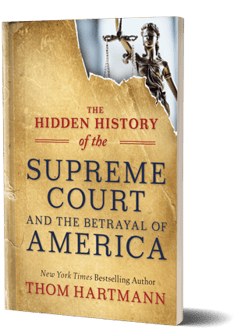Today’s US Supreme Court bears little resemblance to the political makeup of our nation. While that’s created a crisis of legitimacy, it’s a problem with available solutions. The following excerpt from Thom Hartmann's book, The Hidden History of the Supreme Court and the Betrayal of America, explores a few of the options available for remedying our ailing judiciary and offers solutions for how citizens can reverse Lewis Powell’s coup and break the right-wing stranglehold on the Supreme Court specifically, and on our political system generally.
 The following excerpt is from Thom Hartmann's second installment of the Hidden History Series. Read more about the series here.
The following excerpt is from Thom Hartmann's second installment of the Hidden History Series. Read more about the series here.
Article III, Section 2, of the Constitution says that the Supreme Court is, essentially, the final arbiter of all legal disputes in the United States, “with such Exceptions, and under such Regulations as the Congress shall make.” One of those regulations has covered how many justices are on the Court at any given time, a decision that the Constitution hands to Congress.
Regulating the Number of Justices on the Court
Congress has the power to change the number of members on the Supreme Court and has done so for nakedly political reasons several times since the founding of the republic.
Through much of our history, the court was expanded along with the country itself. Judicial regions or circuits were added as the country grew. From the country’s founding until 1891, each member of the Supreme Court would also spend a few months a year “riding the circuit” as the lead judge on the circuit courts.
As new states were added, they needed their own court circuits, so the number of justices on the Supreme Court grew to accommodate the new circuits. It grew to seven in 1807 and nine in 1837. It peaked at 10 in 1863, when the 10th Circuit Court was added for California.
But going all the way back to the battle between Adams and Jefferson in 1800, Congress also had a history of “regulating” the number of justices on the Court for purely political purposes. When the first Judiciary Act became law in 1789, it established the Supreme Court at six members. The Federalists lost executive and legislative power in the election of 1800, but Adams wasn’t about to hand over the federal government to Jefferson completely.
In the months before they had to leave, the furious Federalists passed a law reducing the size of the Court to five members, so that even if someone died or left, Jefferson would not be able to make his own appointments. Weeks after the new Democratic Republican (now known as the Democratic Party) Congress was sworn in, they undid the law, so it never had any impact.
Four generations later, for the 1864 election, Abraham Lincoln replaced his first-term VP, Maine’s Hannibal Hamlin, with a Southerner and a slave owner, Andrew Johnson. Johnson had bought his first slave, a 14-year-old girl named Dolly, the same year he was elected to the Tennessee House of Representatives; over the years between then and 1865 she had borne him three children, and he’d added more slaves to his collection.
When Lincoln was assassinated in the year after he was reelected, the pro-slavery Democrat Johnson became president and things started to come apart. The culmination of that was the successful 1867 impeachment of Johnson in the House, and the Senate’s inability to convict and remove him from office by a single vote.
In 1865, Supreme Court Justice John Catron died, leaving a vacancy on the Court. Catron was a slave owner, and Johnson moved to replace him with Attorney General appointee Henry Stanbery—a political friend of Johnson’s.
Stanbery had been a Democrat, but he’d grown up in Pennsylvania and Ohio, so he wasn’t a slaveholder or a Southerner. Nonetheless, his close affiliation with Johnson upset the Republicans who controlled Congress. He also supported Johnson’s policies of pulling troops out of the South, which would have effectively ended Reconstruction in the South. Republicans in Congress were enraged at the prospect.
So, in the spirit of the Congress of 1800, Congress passed a law in July 1866 to gradually reduce the size of the Court (as individuals died or retired) from 10 members to seven. This not only blocked Johnson from appointing Stanbery but also made it unlikely that he’d get any appointments as president.
In 1868, anti-slavery Republican Ulysses S. Grant took the White House and a solid Republican majority took Congress. Johnson was no longer a threat, and Congress reregulated the Court with the Judiciary Act of 1869, which raised the number of justices to nine. It’s stayed there ever since.
Congress has twice altered the number of justices on the Supreme Court, just to thwart a sitting or incoming president.
Term Limits
Another solution to an out-of-touch Supreme Court is to increase the frequency of the Court’s turnover and to make sure that every president can appoint at least two justices. An 18-year term limit, rolled out over staggered alternate years, would accomplish both goals.
The Constitution, speaking of how long federal judges will serve, says, “The judges, both of the supreme and inferior courts, shall hold their offices during good behaviour, and shall, at stated times, receive for their services, a compensation, which shall not be diminished during their continuance in office.”
The argument against Supreme Court term limits is that the only reason the Constitution specifies for removing a judge is his or her failure to engage in “good behaviour” (like other federal officials, they can also be impeached). In other words, as long as they don’t misbehave, they’re in for life.
But the sentence about judicial terms lumps together both Supreme Court justices and other federal judges. According to multiple constitutional scholars, that means it’s possible to move judges between courts without disrupting their lifetime jobs. This is what happens when elevating judges from the federal courts to the Supreme Court; why not the reverse?
In the Federalist, no. 79, Hamilton lumps the two together when referencing compensation: “The plan of the convention accordingly has provided that the judges of the United States ‘shall at STATED TIMES receive for their services a compensation which shall not be DIMINISHED during their continuance in office.’”
He also noted that the sole technique for complete removal from either federal bench is impeachment: “They are liable to be impeached for malconduct by the House of Representatives, and tried by the Senate; and, if convicted, may be dismissed from office, and disqualified for holding any other. This is the only provision on the point.”
In the Federalist, no. 78, Hamilton again conflated the types of judges when arguing for lifetime tenure: “The standard of good behavior for the continuance in office of the judicial magistracy, is certainly one of the most valuable of the modern improvements in the practice of government.”
Ironically, the Supreme Court itself could determine the constitutionality of judicial term limits. Or must the justices recuse themselves? Here, the knot gets tighter and more complex; there are no easy answers, as the issue has never been subjected to legislative, executive, or judicial review.
But as Thomas Jefferson wrote to John Taylor in 1798 about the bizarre presidency of conservative John Adams: “A little patience, and we shall see the reign of witches pass over, their spells dissolve, and the people, recovering their true sight, restore their government to its true principles.”
The American people want the Court to be an impartial body, providing balance to the legislative and executive branches. Term-limiting Supreme Court appointments, guaranteeing every president at least two appointments, is one tool available to balance the Court.
Cameras in the Courtroom
The Supreme Court is regulated only by Congress and itself. And because Congress has largely chosen not to regulate the Court, it’s chosen to give almost zero oversight to itself.
Several members of the Court don’t even seem to care about the appearance of impropriety: Antonin Scalia went hunting with Dick Cheney weeks before deciding a case in Cheney’s favor;2 Clarence Thomas has shown up at Koch brothers events while ruling on case after case brought to the Court by Koch front groups (all while his wife indirectly takes money from the Kochs via the Heritage Foundation).3
The Court has likewise far removed itself from any oversight by we the people. The Court doesn’t even allow Americans to remotely see Court proceedings. No cameras or recording devices whatsoever are allowed in the Court when it’s in session, and they only release written transcripts after roughly a week has passed.
The benefits are obvious: civic engagement and enlightenment. The costs that have traditionally been posited are the possibility of turning a courtroom into a “circus” and the potential for witness or juror intimidation. There’s also the concern that people who are ultimately found not guilty in a courtroom may be portrayed as guilty simply because they were broadcast as a defendant in court.
The Federal Rules of Civil Procedure—which Congress passed at the request of the Supreme Court in 1937—broadly govern what’s allowed and not allowed in a courtroom. They were designed “to secure the just, speedy, and inexpensive determination of every action and proceeding.”
In 1953, the rules added, “Except as otherwise provided by a statute or these rules, the court must not permit the taking of photographs in the courtroom during judicial proceedings or the broadcasting of judicial proceedings from the courtroom.”
In the 1990s, the Second and Ninth Circuit Courts experimented with permitting television recording of courtroom activity. After all, there are generally no witnesses, and never a jury to be intimidated, and the defendants rarely appear in person in these courts.
The experiment was successful, and the Ninth Circuit has continued to record its proceedings.
The Supreme Court has no jury (arguably, it is the jury) and no defendants (in the cinematic sense). There’s really no good justification for it to prevent video or audio recordings, particularly now that cameras can be made so small as to be functionally invisible to the justices and the lawyers pleading before them.
Article III, Section 2, of the Constitution gives Congress the power, with a simple majority, to “regulate” the Supreme Court. A great starting point would be a simple law requiring the Court to allow nonintrusive live audio/video streaming and recording of its public sessions.
The Constitutional Amendment Remedy for an Out-of-Control Court
The Court has overruled itself 125 times in its history, usually after much time had passed and public sentiment changed, or because new appointments to the Court caused an ideological shift on the bench itself.4
The Court has also been overruled by Congress passing new (and sometimes clarifying) laws 59 times, in areas widely ranging from tax law to immigration to education and crime.
But when the Court uses judicial review to overturn laws, and then holds fast to that conclusion over a substantial period of time, the only remedy that Congress and we the people have is to modify our founding document itself.
Out of more than 24,000 attempts, Congress has successfully amended the Constitution only 18 times in our nation’s history (the first time for all 10 amendments in the Bill of Rights). In six of those instances, Congress (representing we the people) used the amendment process to directly “overthrow” the will of the Court.
The process of amending the Constitution can be drawn out, and even bloody. The 27th Amendment, for example, was first introduced to Congress in 1791 but not ratified until 1992. The 13th, 14th, and 15th Amendments wouldn’t exist if thousands of Americans hadn’t died fighting to secure those rights.
The Equal Rights Amendment, introduced in 1972, is still three states short of ratification.7 This, for a single-sentence Amendment that simply says, “Equality of rights under the law shall not be denied or abridged by the United States or by any state on account of sex,” which is strongly supported by an overwhelming majority of Americans.
When the public sentiment is strong, though, Congress and the states can move fast. For example, the 26th Amendment lowered the voting age to 18. It was first introduced in Congress on March 10, 1971, and ratified just four months later on July 1: a record for the process.
FDR first proposed lowering the voting age during World War II, and Georgia lowered its voting age to 18 in 1943. Eisenhower called for it in his State of the Union address in 1954, and Richard Nixon endorsed it too. But those of us who remember the era give a lot of the credit to Barry McGuire’s song “Eve of Destruction,” with its haunting lyric “You’re old enough to kill, but not for voting.”
Released in 1965, the song quickly hit the Billboard Top 100, and when I was working as a DJ in 1969 and 1970, it was one of the most frequently requested and played of the hourly “golden oldies.” It helped galvanize a movement that crested in the spring of 1971.
While there’s no big hit song today complaining about how the Supreme Court simply invented the twin doctrines of corporate personhood and money is free speech—the central doctrines that have led us to such a corrupted political system—there is a broad and substantial movement across the nation to amend the Constitution to roll back both.8
Amending the Constitution can be a glacially slow process, but it is nonetheless an important way for we the people, via Congress and the states, to remedy harms wrought by the Court.





